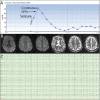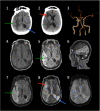Central nervous system complications associated with SARS-CoV-2 infection: integrative concepts of pathophysiology and case reports
- PMID: 32758257
- PMCID: PMC7406702
- DOI: 10.1186/s12974-020-01896-0
Central nervous system complications associated with SARS-CoV-2 infection: integrative concepts of pathophysiology and case reports
Abstract
Coronavirus disease 2019 (COVID-19) is a highly infectious pandemic caused by a novel coronavirus called severe acute respiratory syndrome coronavirus 2 (SARS-CoV-2). It frequently presents with unremitting fever, hypoxemic respiratory failure, and systemic complications (e.g., gastrointestinal, renal, cardiac, and hepatic involvement), encephalopathy, and thrombotic events. The respiratory symptoms are similar to those accompanying other genetically related beta-coronaviruses (CoVs) such as severe acute respiratory syndrome CoV (SARS-CoV) and Middle East Respiratory Syndrome CoV (MERS-CoV). Hypoxemic respiratory symptoms can rapidly progress to Acute Respiratory Distress Syndrome (ARDS) and secondary hemophagocytic lymphohistiocytosis, leading to multi-organ system dysfunction syndrome. Severe cases are typically associated with aberrant and excessive inflammatory responses. These include significant systemic upregulation of cytokines, chemokines, and pro-inflammatory mediators, associated with increased acute-phase proteins (APPs) production such as hyperferritinemia and elevated C-reactive protein (CRP), as well as lymphocytopenia. The neurological complications of SARS-CoV-2 infection are high among those with severe and critical illnesses. This review highlights the central nervous system (CNS) complications associated with COVID-19 attributed to primary CNS involvement due to rare direct neuroinvasion and more commonly secondary CNS sequelae due to exuberant systemic innate-mediated hyper-inflammation. It also provides a theoretical integration of clinical and experimental data to elucidate the pathogenesis of these disorders. Specifically, how systemic hyper-inflammation provoked by maladaptive innate immunity may impair neurovascular endothelial function, disrupt BBB, activate CNS innate immune signaling pathways, and induce para-infectious autoimmunity, potentially contributing to the CNS complications associated with SARS-CoV-2 infection. Direct viral infection of the brain parenchyma causing encephalitis, possibly with concurrent neurovascular endotheliitis and CNS renin angiotensin system (RAS) dysregulation, is also reviewed.
Keywords: ACE2; Blood-brain barrier; COVID-19; Cytokines; Encephalitis; Encephalopathy; Endothelial cells; Microglia; SARS-CoV-2; Stroke.
Conflict of interest statement
The authors declare that they have no competing interests.
Figures






References
-
- Guan WJ, Zhong NS. Clinical characteristics of Covid-19 in China. Reply N Engl J Med. 2020;382:1861–1862. - PubMed
Publication types
MeSH terms
LinkOut - more resources
Full Text Sources
Other Literature Sources
Medical
Research Materials
Miscellaneous

